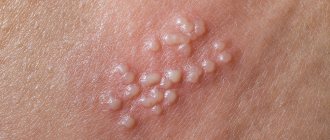What is herpes? Types of infection
The disease is incurable. The virus can “sleep” in the body for years. But, as soon as for some reason the body’s defenses weaken, the clinical picture of the disease will appear. There are 2 types of herpes virus:
- HSV-1 (so-called labial)
- HSV-2 (genital: rashes appear on a person's genitals)
The second type of herpes is very dangerous for those who are pregnant. This is a TORCH infection. A woman should definitely be checked for a number of such infectious diseases at the stage of pregnancy planning, because they can harm the development of the fetus.
Eppstein-Barr virus
The Epstein-Barr virus predisposes to premature termination of pregnancy, fetal malnutrition, and in newborn children it causes damage to the nervous system, visual organs, recurrent chroniosepsis, hepatopathy and respiratory distress syndrome. However, this virus provokes the listed pathologies only under certain conditions, under which it becomes dangerous during pregnancy. It is very bad if a pregnant woman has not previously encountered the Eppstein-Barr virus, which is why she does not have antibodies to this virus in her body. If there was contact, and antibodies were detected after treatment, then this is a good sign, because in this case there is nothing to be afraid of. This serves as evidence that if a woman’s body becomes infected again, she will cope with this dangerous disease on her own. This means that a pregnant woman will not have to take medications that are heavy and quite dangerous for the development of the fetus.
Ways of spreading the disease
HSV-1 is transmitted in the following ways:
- contact-household
- airborne
Airborne transmission means that the virus is transmitted from an infected person to a healthy person through touching (only through those areas where there are rashes), kissing, etc. By using the personal belongings of an infected person, you have every chance of becoming infected. Therefore, a pregnant woman should only use her own cosmetics, toothbrush, body washcloth, towels and dishes.
HSV-2, that is, the genital type of herpes infection, is transmitted through sexual contact (coitus). In half of the cases, a woman becomes infected from a partner who currently has no significant symptoms, but may only have a small rash, mild pain and a slight burning sensation, nothing more. Such symptoms often seem not to threaten a man’s health, and he does not go to the doctor, infecting his partners through kissing, touching and unprotected sexual intercourse.
If a pregnant woman becomes infected with herpes for the first time, the fetus will become infected in 50-60 cases out of 100. These are very high chances of getting sick. Vertical transmission of genital herpes is also possible (through the placenta or during childbirth). During the birth process, the baby passes through the birth canal, where the virus is localized and there are rashes. His immunity is still too weak to resist such an infection, and infection occurs literally in minutes.
Most of the population suffers from herpes due to the fact that it is very easily transmitted. Therefore, those who are expecting a child need to be tested before pregnancy and monitor their immune status for all 9 months.
Cytomegalovirus (C in abbreviation for ToRCH infection)
Cytomegalovirus was discovered only in the 20th century. The infection is transmitted sexually, with blood, through saliva (for example, through kissing), and also from mother to child during breastfeeding. It is currently believed that about 80% of women of childbearing age are carriers of this infection.
In most cases, cytomegalovirus is in a “dormant” state. Sometimes the infection appears as a common cold, but more often there are no symptoms of the disease. And only with a significant decrease in immunity does the threat of the disease progress to an acute form arise.
The greatest danger to the fetus is primary infection with cytomegalovirus. It is especially dangerous to become infected in the first trimester. This can lead to underdevelopment or hydrocele of the child's brain, jaundice, enlargement of the liver and spleen, the development of heart defects and congenital deformities.
Symptoms (manifestations)
The two types of herpes described above give rashes in different places of the body. But the symptoms are similar:
- rashes that look like blisters
- burning and itching of the mucous membranes of the genital organs
- headache
- muscle pain
- weakness in the body
- temperature is about 38 - 39 degrees
In the place through which the pathogen entered the woman’s body, burning and itching first begins. But only after a while a rash appears. Blistering rashes are called "vesicles." They are filled with serous contents that have no color. The blisters of labial herpes are found mainly on the lips, sometimes on the nose. With genital herpes, accordingly, the rash will be on the labia, in the vagina, on the cervix and even in the anus area.
Several days pass before the bubbles open and their contents come out. Small ulcers remain at the site of the rash. If you touch them, pain will occur. Wounds take a long time to heal. With genital herpes, pregnant women may experience vaginal discharge of a watery consistency for 5-7 days. This is one of the symptoms of genital herpes.
Recurrent genital herpes during pregnancy is clinically similar to primary herpes, but the symptoms are not so obvious. As we know, during pregnancy a woman’s immunity decreases (so that she can carry a child without the body rejecting it), so the disease recurs. Doctors call such relapses relapses. After an exacerbation, a stage of remission usually follows.
Remission means that the pathogen remains in the body, but there are no longer typical obvious symptoms. Relapses are similar in symptoms to the clinical picture of primary herpes.
Possible consequences for mother and child
Primary infection with genital herpes during pregnancy increases the risk of infection of the fetus.
Possible complications include:
- intrauterine infection of the fetus;
- miscarriage, miscarriage (in the 1st trimester);
- premature birth, prematurity;
- fetal malformations (encephalitis, hydrocephalus, etc.).
Herpes of the first type (labial) does not cause complications or concerns. But local therapy is still necessary.
Neonatal herpes of the newborn
Infection of a child with primary herpes occurs in approximately 50 cases out of 100, with secondary herpes - much less often. Neonatal herpes poses a risk to the health of the newborn. Therefore, it is necessary to remind once again how important it is to be examined at the stage of pregnancy planning and to undergo timely treatment at the first symptoms of the disease.
Features of herpes in newborns:
- infection in the womb occurs less frequently, mainly at the time of birth, passing through the mother’s birth canal;
- the development of primary herpes in the mother, especially closer to childbirth, increases the risk of the disease in the child;
- Symptoms of neonatal herpes can occur immediately after birth, sometimes after 5 weeks from birth.
Forms of neonatal herpes:
- generalized. The skin (sometimes mucous membranes) of the child is affected, as well as the liver, nervous system and other organs;
- damage to the central nervous system (CNS). There are no skin rashes;
- encephalitis or hydrocephalus (brain damage);
- damage to the oral cavity and conjunctiva without involving the central nervous system and internal organs.
Infection of a child can also occur after childbirth, through touching an infected mother.
The disease often begins unexpectedly and without obvious symptoms of herpes. The newborn eats poorly, and there is increased tearfulness and irritability. After which the body temperature rises and respiratory problems appear. The skin may show jaundice and hemorrhagic diathesis (point hemorrhages). Most newborns do not develop rashes.
Important! It is very important to recognize neonatal herpes in time, since if left untreated it can cause irreversible consequences. You must contact your pediatrician immediately if there are any deviations from the norm or changes in the child’s behavior, and you must also inform the mother about the presence of herpes.
Herpes zoster
This is a very dangerous form of the disease for pregnant women. The causative agent is also a virus. Unilateral rashes appear on the skin, similar to those of herpes. In areas of the rash, pain occurs, which is explained by the localization of the causative virus in human nerve cells.
Herpes zoster is caused by the chickenpox virus. It exists latently in the body for a certain period, and when the defenses decrease, it begins to attack the body. Forms of the disease:
- motor
- ophthalmologically
- Ramsay-Hunt syndrome
Atypical forms of herpes zoster include:
- hemorrhagic
- gangrenous
- abortifacient
- cystic
Accordingly, manifestations may be different. But in all cases, a rash appears along large nerve trunks and nerves. The nature of the lesion, as noted above, is one-sided. At the same time, the patient feels unwell and has a fever.
After some time, neuralgic pain appears in the affected areas. At first, pink spots are visible on the skin, and after a few days, erythematous papules and blisters containing serous fluid form against their background. When the appearance of the rash changes, the nearby lymph nodes become enlarged. Also, pain along the nerves becomes even more noticeable, causing discomfort to the sick woman.
After about 7 days, the exposed rash dries out and becomes crusty. After some time, the crusts fall off, leaving pigmented skin in their place. When the symptoms of herpes have disappeared, you may still feel pain along the nerves, which is called postherpetic neuralgia. It is very difficult to cure her.
Recurrent herpes
In 50%-70% of people the disease becomes chronic. This is facilitated by:
- untimely or incorrect treatment;
- decreased immunity, including that caused by taking medications that suppress the immune system;
- presence of other STDs;
- strict diets, vitamin deficiencies;
- state of chronic stress.
Why do patients develop relapses, during which the disease affects the same parts of the body? There are several reasons for this:
- Having penetrated the body, the virus settles in the tissues of the genital organs. As it multiplies, it affects cells deeper and deeper until it reaches nerve cells - neurons connected to each other by processes - axons. Through them, like bridges, the pathogen reaches the cells of the spinal cord, into which it introduces its DNA.
- An infected brain cell becomes an “incubator” for viruses, which periodically return via axon bridges to the mucous membrane or skin, causing new rashes. Schematically, the process is similar to the migration of birds, constantly returning to their “native places.”
- The immune system cannot kill viruses hidden in the spinal cord, but it deals with those that have left the “shelter”. Therefore, with high immunity, relapses occur rarely or not at all. But as soon as the body “loses its vigilance” - weakens, gets sick, catches a cold, is exposed to stress - the pathogens begin to overcome the immune defense. As a result, they reach their target - the skin and mucous membranes of the genital organs. Here, the increased reproduction of viral particles inside the “captured” cells begins. Cellular structures, dying, release myriads of viruses that cause inflammation, redness, swelling and the appearance of blisters. Herpes is causing another aggravation.
- Gradually, the immune system fights back the virus, and within 10 days the ulcers at the site of the rash dry out and heal. Everything returns to normal, so that at the slightest weakening of the immune system it can start again.
From the mechanism of exacerbations, it becomes clear why herpetic eruptions appear in the same places. It’s just that the virus cells return back only through the nerve cell from which they penetrated deep into the body.
Types of recurrent herpes
Depending on the number of exacerbations, several types of the disease are distinguished:
- mild, occurring up to 3 times a year;
- moderate severity, in which exacerbations occur 4-6 times a year;
- severe, accompanied by frequent exacerbations, intervals between which do not exceed a month;
- arrhythmic, in which after a period of imaginary well-being, lasting from a month to five, rashes appear. This form of herpes is characterized by a pattern - the longer the remission, the more severe the disease;
- menstrual, manifested by rashes during menstrual periods. This type of disease is severe and difficult to treat;
- subsiding, in which the manifestations of the disease constantly become weaker, and the inter-relapse periods become longer. The subsidence of the manifestations of the disease indicates the positive dynamics of treatment and the restoration of immune defense that suppresses the virus.
Diagnostics
Enzyme immunoassay is a very reliable diagnostic method. It allows you to detect both labial and genital herpes in a woman. ELISA detects immunoglobulins G and M in the patient’s blood. After infection, Ig M first appears in the blood. And after 2-4 weeks, Ig G can be detected (after primary infection or resumption of a pre-existing disease).
Types of ELISA:
- qualitative
- quantitative
The last of these provides information about the titer of immunoglobulins, that is, their quantity. Quantitative ELISA allows you to assess whether the patient has immunity to the herpes pathogen.
In addition to ELISA, diagnosis is carried out using PCR or virological culture. The fact that a woman has herpes is indicated to the doctor by symptoms that point specifically to this disease.
Laboratory diagnostic methods:
- serology
- culture method
- immunofluorescent reaction
- microscopic examination
In 80 women of reproductive age out of 100, antibodies to the causative agent of herpes simplex type 1 are detected during testing. Antibodies in the same patients to the second type virus are found in 30 women out of 100. Those who want to conceive a child, and those who are already pregnant, worry when ELISA detects herpes in the body. But there is no need to worry, because a herpes test shows whether there are protective antibodies in the blood.
If you have IgG, then the fetus is not in danger. This is even good, because herpes will not be passed on to the child, because the mother has immunity. If (IgM) is detected, this may indicate a recurrence of herpes, which the woman was once infected with and which was latent.
IgM remains in the body for only one or maximum two months. IgG antibodies will remain in the blood throughout your life, which in medical language is called seropositivity. If a primary infection has occurred, then IgM and a 4-fold increase in IgG are detected, which are detected during studies with a break of 12 days.
A relapse of the disease in a woman is indicated by a large amount of IgG and the appearance of IgM. If questionable results regarding IgM were obtained, you need to take the test again after 10 or 12 days.
Methods for diagnosing ToRCH infections
To diagnose ToRCH infections, you can contact Family Doctor JSC. The most convenient form of diagnosis is the laboratory profile “Diagnostics of the ToRCH infection complex,” which includes serological tests to detect antibodies to all pathogens included in the ToRCH infection complex.
Avidity tests will determine how long a particular infection has been present in the body.
Gynecologists at the Family Doctor will advise you on test results and give recommendations on how to ensure the safety of the fetus, carry and give birth to a healthy child.
Serological blood test
Serological analysis allows you to identify antibodies to the causative agent of a specific disease. In order to ensure the absence of ToRCH infections, it is necessary to conduct tests for antibodies to each of the four diseases included in this group.
More information about the diagnostic method
Determination of avidity to antibodies of ToRCH pathogens
The most dangerous infection with ToRCH infections is directly during pregnancy. ToRCH infections are widespread, therefore, if the presence of the corresponding antibodies in the blood is detected, this does not mean that the infection occurred during pregnancy. In order to find out whether there was an infection during this period, avidity is determined (an assessment of the strength of the bond between antibody and antigen). At the beginning of the disease, this connection is rather weak. Over time, the immune system produces antibodies with higher avidity. Therefore, the detection of low-avidity antibodies may indicate a relatively recent infection.
Sign up for diagnostics To accurately diagnose the disease, make an appointment with specialists from the Family Doctor network.
Rate how useful the material was
thank you for rating
The effect of herpes on the fetus
If a woman is initially infected, the child becomes infected in more than half of the cases. If the primary infection does not make itself known by characteristic symptoms, then the risk of transmission to the fetus is 40%. If the course of herpes in a pregnant woman passes without clinical manifestations or there is a recurring infection, then transmission to the fetus occurs in only 0-4 cases out of 100.
Consequences of primary infection of a pregnant woman with herpes pathogen:
- gestational disorders (miscarriage, polyhydramnios, premature birth
- pathologies of fetal development (stillbirth, intrauterine infection, spontaneous abortion)
- pathologies of the newborn (various malformations, body weight below normal, congenital form of herpetic infection, prematurity)
If a pregnant woman notices herpetic rashes on her lips, you don’t have to worry about the condition of the fetus. Immunity is created that will prevent the child from becoming infected. But local therapy (ointments, etc.) is needed.
During primary infection with the pathogen, the consequences for the fetus depend on what month of gestation the woman is in. In the first trimester there is a high chance of miscarriage or missed abortion. This means that the woman cannot bear a child and will not give birth. With primary infection in the fourth, fifth or sixth month, the child may experience developmental abnormalities that lead to fetal death. If infection occurs in the last 3 months of gestation, then there is a danger for both the expectant mother and the child.
Consequences of infection of a pregnant woman with herpes in the 7-9th month:
- physical development disorders
- severe damage to the central nervous system
- pneumonia
- heart defects
- defects in brain formation
- significant hearing and vision impairment
For the mother, infection in the last trimester threatens inflammation. Exacerbation of genital herpes is slightly less dangerous. During childbirth in such cases, the child runs the risk of contracting herpes. Therefore, before childbirth, special therapy is carried out for the mother. If the therapy does not give the desired effect, then a caesarean section is performed instead of a natural birth.
The fetus becomes infected through the eyes and nasopharynx when passing through the genital tract of a sick mother. The first symptoms will not be specific. But a diagnosis can be made within a few days of the baby’s life in order to prescribe the correct treatment.
Recurrence of herpes during pregnancy
If a woman was already a carrier of herpes at the time of conception, then in most cases intrauterine infection of the fetus will not occur. The embryo is under reliable protection of antibodies produced by the mother's body. However, there remains a risk of infection during childbirth. Therefore, the slightest rash of blisters on the perianal area requires immediate treatment. Doctors also recommend immediate removal of papillomas in intimate places if they appear during pregnancy.
In some cases, severe recurrent herpetic infection is an indication for cesarean section.
Treatment of herpes during pregnancy
Any treatment during pregnancy can result in dire consequences for the fetus and the mother. Medicines are not recommended. But there are conditions that are better treated. Panavir is used internally and externally. Labial herpes can be cured with acyclovir, analogues of which are Zovirax, Vivorax and Acigerpin. Any of these ointments lubricate the rash on the skin and mucous membranes. This must be repeated 3-5 times a day, the course is 7 days.
The doctor may prescribe other local ointment treatments for the pregnant woman:
- tetracycline
- erythromycin
- tebrophenic
- oxolinic
- alizarin
Active herpes during pregnancy requires treatment. The rash is lubricated with a solution of interferon and vitamin E. Thanks to it, the ulcers heal with a crust faster. If a pregnant woman has very low immunity, she is prescribed appropriate medications:
- B vitamins
- echinacea
- Eleutherococcus
- ginseng
In rare cases, treatment with immunoglobulins is necessary. As for folk methods, wounds on the genitals and lips are smeared with rosehip, sea buckthorn or fir oil. An ointment based on chamomile or calendula flowers is also sometimes used. This method helps the sores heal in a shorter time.
In order to give birth naturally, without having to have a cesarean section, in the third trimester, a woman is prescribed Acyclovir to treat herpes. The course is 2-3 weeks before the planned delivery. 200 mg is administered four times a day. This is a fairly safe method for the fetus. Also, the genital tract of a woman who will give birth without a cesarean section is treated with Poludan solution. It kills the virus locally.
To understand whether a 9-month pregnant woman has herpes or not, the doctor checks her for the presence of a rash on the genitals. If a rash is found, a caesarean section will most likely be recommended. Indications for surgical delivery are also:
- infection with herpes for the first time in life in the 9th month of gestation, when there are no antibodies to the pathogen in the blood
- detection of herpes during PCR from the cervical canal before childbirth
- severe herpes that cannot be cured with acyclovir
How can you get infected with herpes
The content of the article
The disease is caused by the herpes simplex virus (HSV, Herpes simplex virus). Of the eight types of this pathogen, genital lesions are the result of two infectious agents. HSV-2 causes 80% of cases of the disease, and HSV-1 - 20%. There are also combined infections, in which both viral types are to blame.
There is a misconception that herpes on the lips and genitals are completely different diseases. In fact, both types of pathogens often “swap places” during domestic infection and oral sex. And both infections are equally dangerous.
Both types of virus are transmitted:
- For all types of sexual contact - vaginal, oral, anal, during which the virus enters the body through microdamage to the mucous membrane. You can also become infected from a partner who does not have rashes on the genitals or other manifestations of the disease. This condition is possible with strong immunity, when the virus lies low and waits in the wings. A person becomes a carrier of a herpes infection, but does not experience any health problems.
- Through common objects - washcloths, sponges, bed linen, towels. A person with a cold sore caused by the type 1 virus can become a source of genital herpes infection.
- During autoinoculation (self-infection), when the patient transfers the pathogen from the face to the genitals.
- A child becomes infected from a sick mother when the virus penetrates from the vagina into the uterus or transplacentally through the placenta. During childbirth, infection occurs as the newborn passes through the birth canal.
Statistics of hidden and overt forms of herpes
The body cannot overcome the pathogen on its own. The virus settles in the roots of the spinal cord, and the infected person continues to live with the disease throughout his life.
The pathogen can remain in the body for many years without causing symptoms. Therefore, it is impossible to know without testing for herpes whether a person is infected with the virus. According to WHO, type 1 herpes, which causes a rash on the lips and genitals, affects 67% of the world's inhabitants, and type 2 affects 11% of people. Only 20% of the disease occurs in the classical form, which is beyond doubt. In the rest, the course of the disease is latent or asymptomatic.
Prevention
The main measures to prevent herpes in pregnant women are:
- testing for the herpes virus when planning to conceive (before you become pregnant)
- rejection of bad habits
- strengthening the immune system (hardening, balanced nutrition, physical activity and healthy lifestyle in general)
If you know about your recurrent herpes, you need to be treated before pregnancy with multivitamin complexes and immunomodulatory drugs as prescribed by your doctor. Laser therapy may also be recommended to help make the virus less active. You should also avoid contact with those who have recurrent herpes. Health to you and your baby!
Atypical forms of herpes
Sometimes genital herpes is erased. These forms of the disease account for 65% of cases of the disease:
- In women,
atypical herpes resembles inflammation of the vagina or vulva. There is pain, itching and swelling of the genital organs, profuse leucorrhoea and pain during sexual intercourse. External manifestations are limited to areas of redness or pinpoint rashes. - In men,
the atypical form of the disease is similar to inflammation of the head and foreskin (balanitis or balanoposthitis). A reddish rash appears on the mucous membrane of the penis, accompanied by pain and burning, which does not look like a herpetic rash. Inflammation of the prostate gland occurs, causing pain radiating to the anal area. Damage to the urethra leads to pain and burning when urinating, and the appearance of traces of blood in the urine.
There is a latent form of the disease in which there are no clinical manifestations, but despite this, the person remains a source of infection. But imaginary well-being does not last forever. With hypothermia, loss of strength, decreased immune defense, pregnancy, stress, severe concomitant diseases and other unpleasant conditions, the virus begins to multiply rapidly and the person becomes ill.
The disease is activated by concomitant sexually transmitted infections, especially ureaplasmosis. Due to the ability to rapidly “bloom” against a background of weakened immunity, herpes occurs in 90% of HIV patients. Therefore, if herpetic rashes appear, you need to be examined for other STDs.
Symptoms of genital herpes
The incubation period varies from two to 12 days, during which the pathogen multiplies in the skin layers.
The disease occurs in several stages.
During primary infection, herpes manifestations (typical or atypical) appear.
Options for the development of the disease:
- asymptomatic (subclinical form)
- local affected area (there is only one “entry gate” of the pathogen)
- damage to several places at the same time (the pathogen invades several areas).
Latent infection is characterized by the absence of traces of HSV in the analyzed biological samples, but the persistence of the pathogen in the nerve ganglia.
This condition occurs as a result of a primary infection or develops after the first symptomatic manifestations.
Recurrence is the resumption of symptoms after an asymptomatic period.
The typical form of the disease is characterized by:
- the initial period , lasting up to two days, is characterized by pain, burning sensations, tingling, itching, and sometimes urination problems
- period of rashes - bubbles appear on the swollen and reddened genitals, which spontaneously burst with the formation of erosions; patients complain of increased pain, itching, and weeping (lasting about a week)
- regression - crusts form at the site of erosion, after which the colored areas remain for some time (duration about one to two weeks)
Often the disease occurs without a characteristic rash.
In this case, complaints may only be of moderate swelling and redness.
Severe pain radiates to nearby organs and skin areas without any special external manifestations.
The total duration of manifestations during primary infection can reach 6 weeks.
Recurrence of infection is less pronounced.
Duration is up to 15 days, the severity of symptoms is less intense, the crusts disappear in about 4 days.
In addition to the external genitalia, the virus can affect women:
- vaginal walls
- uterus with appendages (ovaries, tubes)
- urethra
- bladder
- renal pelvis
Up to 80% of women with primary infection with HSV-2 have manifestations of cervicitis, in the form of extensive erosion (bright scarlet, with ulcers) on the cervix.
The disease takes on a particularly complex course against the background of an existing state of immunodeficiency (physiological in newborns or acquired).
Diagnosis of herpes
If genital herpes is suspected, after an external examination, scrapings from the affected areas, blood, and urine are taken for examination. This will allow you to differentiate the disease from other skin lesions that have similar symptoms.
For diagnostics the following is used:
- Cultural method - during the study, the contents of the vesicles are transferred to a growing chicken embryo; if it dies, the disease is confirmed. The method is reliable, but too time-consuming.
- PCR is a test that detects viral DNA in tissues. The method allows you to calculate the pathogen even from a small amount of viral material. Effective for diagnosing any form of disease, incl. hidden. The method can be used immediately after infection before symptoms of the disease appear. PCR not only detects the virus, but also determines its type.
- Methods aimed at determining antigens and antibodies to the pathogen: ELISA - immunofluorescence diagnostics, CFR (complement fixation reaction), various types of agglutination reactions. With their help, you can identify the type of pathogen, determine its quantity and duration of infection.
A complete diagnosis of herpes virus infection allows you to make the correct diagnosis in order to prescribe treatment.
Herpes in newborns
A child becomes infected with the pathogen from the mother in utero or by passing through an infected genital tract during childbirth. In newborns, the mucous membranes of the eyes and mouth, skin, and genitals are affected. When the pathogen enters the child’s brain, meningoencephalitis occurs, causing death or severe disability.
A generalized form is possible, in which all organs and systems of the newborn are affected. The child experiences jaundice, respiratory distress, and urinary retention. Children are restless, do not latch on to the breast, and are vomiting. Death occurs from shock, bleeding, dehydration, intoxication, and organ failure.
The likelihood of infection increases with primary infection of the mother in late pregnancy.
The causative agent of genital herpes
There are HSV serotypes 1 and 2.
About 80% of genital herpes lesions are caused by HSV-2, and infection with both types is also possible.
As a result of genital-oral contact, HSV-2-related lesions of the oropharynx occur.
Specific features of this pathogen:
- located and multiplies in nerve and lymph nodes
- spreads throughout the body through the bloodstream
- can cause lymphocytic, neutrophilic and macrophage changes, weakening immunity at the cellular level
Primary infection with genital herpes
If primary genital herpes occurred in the second trimester of pregnancy (as well as in the first) or in the past there was a high frequency of exacerbations of the disease (more than 6 episodes per year), acyclovir is prescribed in the last 4 weeks before childbirth.
This reduces the risk of relapse of the disease.
When primary genital herpes appears after the 34th week, for example, at the 37th week of pregnancy, a cesarean section is planned to prevent neonatal infection.
Due to the fact that at the time of birth there may be a significant release of the virus, leading to infection of the child.
If primary genital herpes occurs during pregnancy (3rd trimester, end of the period) and it is impossible to avoid natural delivery, treatment is carried out for both mother and child:
- the mother is prescribed oral acyclovir at a dosage of 200 mg 5 times a day, for a period of up to 10 days, or 400 mg, 3 times a day
- acyclovir is prescribed to a newborn at a rate of 20 mg/kg body intravenously 3 times a day for up to three weeks
Alternatively, an analogue of acyclovir, valacyclovir, can be used.
In addition, if a pathology such as genital herpes manifests itself during pregnancy, ointments containing acyclovir can alleviate the condition of the pregnant woman.
Since external agents are not absorbed into the blood, they do not affect the fetus.
Recent studies have found that taking acyclovir and valacyclovir during the first trimester of pregnancy does not increase the risk of serious birth defects.
Acyclovir is recognized to be safe during pregnancy and can be prescribed for medical reasons.
A relative disadvantage of the drug is that it may reduce the production of antibodies to the primary viral infection.
Just like any medicine, nucleosides can lead to the development of undesirable effects (allergic reactions, headaches, bowel disorders, etc.).
If side effects occur, it is necessary to discuss further treatment tactics with your doctor.
The use of acyclovir is strictly necessary in situations with disseminated variants of the disease, accompanied by the development of encephalitis, hepatitis, etc. in the expectant mother.
The use of other medications (for example, immunomodulators, etc.) is not justified.
Since today there are no drugs alternative in effectiveness to nucleoside derivatives.
Monitoring after completion of treatment is not required.









